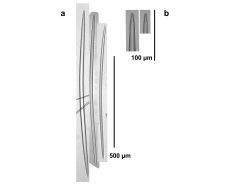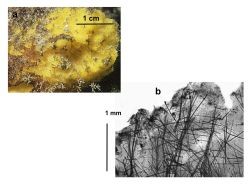yellow
cinnamon-tan
orange-yellow
branching
encrusting
lobate
massive
tough
Colombia
Axinyssa ambrosia
Description: (Excerpt from Zea et al., 2013) Irregular masses, 2-3 cm thick, usually up to 10-15 cm wide but sometimes greater, with lobate to digitiform, and sometimes stalked, cylindrical projections, up to 1-2 cm in height-width; sometimes as repent to partly projecting branches, ca. 10 cm long, 1-3 cm wide. Surface organic, rugose, with microconulose to microhispid areas; some areas honeycombed; loosely to strongly fouled. Oscules small, up to 3 mm in diameter, scarce, irregularly scattered, latero-basal to conical or mound-shaped projections or on sides (sometimes on top) of digitiform projections. Consistency compressible but not resilient, slightly difficult to tear, spiculose. Color bright yellow to orange-yellow, with vinaceous shades on the exterior, especially on top of elevations; some specimens fixed directly in ethanol turn black, yielding a dark brown ink. Ectosome organic; pinacoderm supported and sometimes pierced by projecting spicules, spicule tracts. Choanosome non-cavernous; skeleton of a confused arrangement of spicules in between ascending, radiating and anastomosing spicule tracts, 50-130 µm wide, 2-10 spicules across. Spicules slightly curved, stout oxeas, with symmetrical, rather long, hastate, mucronate and stepped ends; axial canal often visible; a few fusiform oxea as developmental stages; a few strongyloxeas and anysostrongyles; length 490-941 µm; width 4.8-23.8 µm.
Notes: (Excerpt from Zea et al., 2013) This appears to be a deep-water species which occur on reefs in places like at Santa Marta, Colombia, where there is seasonal upwelling of colder waters. In Curaçao it also occurs in reefs at 18–20 m in depth. At Santa Marta, it is occasional in deep reef areas, usually growing on dead sides or on undersides of corals, 18–35 m in depth. The species was originally described under genus Rhaphisia. Co-existing A. yumae (Pulitzer-Finali, 1986) (also pictured in this guide) was erroneously synonymized to A. ambrosia.A. ambrosia is distinguished from A. yumae by its irregular shape and smaller oscules in the former vs. clusters of volcano-shaped lobes to tubes in the latter. Spicules are predominantly oxeas in A. ambrosia and always anysostrongyloxeas (fusifom styles) in A. yumae. The Jamaican material described by Lehnert and van Soest (1999) can be ascribed to A. ambrosia by its slightly larger (720–1160 µm x 6–16 µm) oxea with telescoped ends. The material from the Bahamas described by Diaz et al. (1993) was not studied here and may deserve further analysis. Axinyssa sp. described by Moraes (2011) from the Archipelago of São Pedro e São Paulo, off Brazil, may belong to this species.
Author Reference: (de Laubenfels, 1936)
Link: World Porifera Database

![<i>Axinyssa ambrosia</i> <br />[Colombia, Santa Marta]](mini/00066/01807.jpg)
![<i>Axinyssa ambrosia</i> <br />[Colombia, Santa Marta]](mini/00066/01808.jpg)
![<i>Axinyssa ambrosia</i> <br />[Colombia, Santa Marta]](mini/00066/01813.jpg)
![<i>Axinyssa ambrosia</i> <br />[Colombia, Santa Marta]](mini/00066/01814.jpg)
![<i>Axinyssa ambrosia</i> <br />[Colombia, Santa Marta]](mini/00066/01815.jpg)
![<i>Axinyssa ambrosia</i> <br />[Colombia, Santa Marta]](mini/00066/01816.jpg)
![<i>Axinyssa ambrosia</i> <br />[Colombia, Santa Marta]](mini/00066/01818.jpg)
![<i>Axinyssa ambrosia</i> <br />[Colombia, Santa Marta]](mini/00066/01819.jpg)

